Sixian Li
TL-Training: A Task-Feature-Based Framework for Training Large Language Models in Tool Use
Dec 20, 2024



Abstract:Large language models (LLMs) achieve remarkable advancements by leveraging tools to interact with external environments, a critical step toward generalized AI. However, the standard supervised fine-tuning (SFT) approach, which relies on large-scale datasets, often overlooks task-specific characteristics in tool use, leading to performance bottlenecks. To address this issue, we analyze three existing LLMs and uncover key insights: training data can inadvertently impede tool-use behavior, token importance is distributed unevenly, and errors in tool calls fall into a small set of distinct categories. Building on these findings, we propose TL-Training, a task-feature-based framework that mitigates the effects of suboptimal training data, dynamically adjusts token weights to prioritize key tokens during SFT, and incorporates a robust reward mechanism tailored to error categories, optimized through proximal policy optimization. We validate TL-Training by training CodeLLaMA-2-7B and evaluating it on four diverse open-source test sets. Our results demonstrate that the LLM trained by our method matches or surpasses both open- and closed-source LLMs in tool-use performance using only 1,217 training data points. Additionally, our method enhances robustness in noisy environments and improves general task performance, offering a scalable and efficient paradigm for tool-use training in LLMs. The code and data are available at https://github.com/Junjie-Ye/TL-Training.
SafeAligner: Safety Alignment against Jailbreak Attacks via Response Disparity Guidance
Jun 26, 2024Abstract:As the development of large language models (LLMs) rapidly advances, securing these models effectively without compromising their utility has become a pivotal area of research. However, current defense strategies against jailbreak attacks (i.e., efforts to bypass security protocols) often suffer from limited adaptability, restricted general capability, and high cost. To address these challenges, we introduce SafeAligner, a methodology implemented at the decoding stage to fortify defenses against jailbreak attacks. We begin by developing two specialized models: the Sentinel Model, which is trained to foster safety, and the Intruder Model, designed to generate riskier responses. SafeAligner leverages the disparity in security levels between the responses from these models to differentiate between harmful and beneficial tokens, effectively guiding the safety alignment by altering the output token distribution of the target model. Extensive experiments show that SafeAligner can increase the likelihood of beneficial tokens, while reducing the occurrence of harmful ones, thereby ensuring secure alignment with minimal loss to generality.
Advancing Translation Preference Modeling with RLHF: A Step Towards Cost-Effective Solution
Feb 27, 2024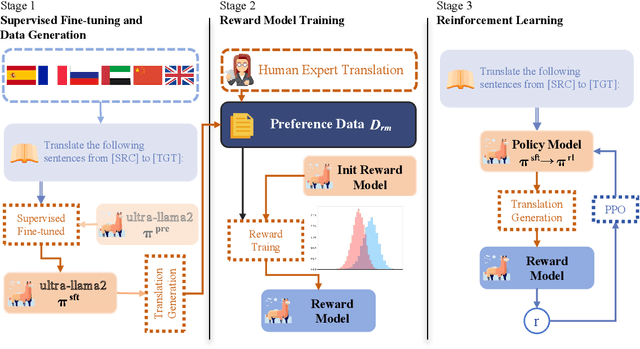

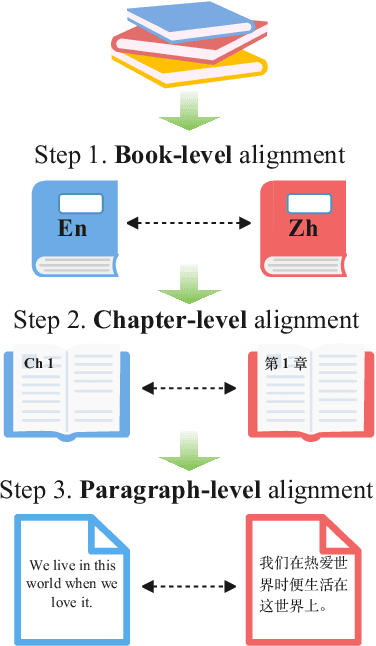
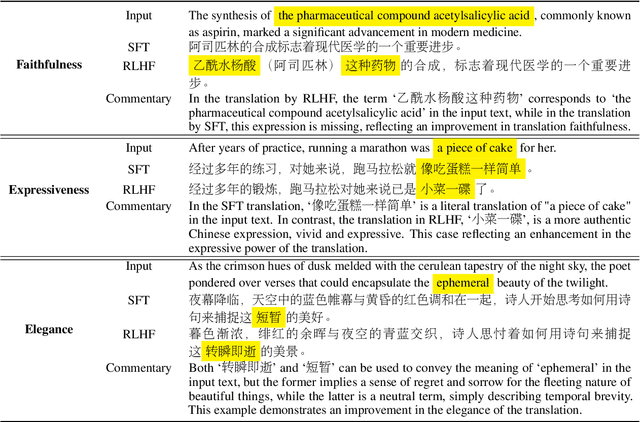
Abstract:Faithfulness, expressiveness, and elegance is the constant pursuit in machine translation. However, traditional metrics like \textit{BLEU} do not strictly align with human preference of translation quality. In this paper, we explore leveraging reinforcement learning with human feedback (\textit{RLHF}) to improve translation quality. It is non-trivial to collect a large high-quality dataset of human comparisons between translations, especially for low-resource languages. To address this issue, we propose a cost-effective preference learning strategy, optimizing reward models by distinguishing between human and machine translations. In this manner, the reward model learns the deficiencies of machine translation compared to human and guides subsequent improvements in machine translation. Experimental results demonstrate that \textit{RLHF} can effectively enhance translation quality and this improvement benefits other translation directions not trained with \textit{RLHF}. Further analysis indicates that the model's language capabilities play a crucial role in preference learning. A reward model with strong language capabilities can more sensitively learn the subtle differences in translation quality and align better with real human translation preferences.
ToolSword: Unveiling Safety Issues of Large Language Models in Tool Learning Across Three Stages
Feb 16, 2024Abstract:Tool learning is widely acknowledged as a foundational approach or deploying large language models (LLMs) in real-world scenarios. While current research primarily emphasizes leveraging tools to augment LLMs, it frequently neglects emerging safety considerations tied to their application. To fill this gap, we present $ToolSword$, a comprehensive framework dedicated to meticulously investigating safety issues linked to LLMs in tool learning. Specifically, ToolSword delineates six safety scenarios for LLMs in tool learning, encompassing $malicious$ $queries$ and $jailbreak$ $attacks$ in the input stage, $noisy$ $misdirection$ and $risky$ $cues$ in the execution stage, and $harmful$ $feedback$ and $error$ $conflicts$ in the output stage. Experiments conducted on 11 open-source and closed-source LLMs reveal enduring safety challenges in tool learning, such as handling harmful queries, employing risky tools, and delivering detrimental feedback, which even GPT-4 is susceptible to. Moreover, we conduct further studies with the aim of fostering research on tool learning safety. The data is released in https://github.com/Junjie-Ye/ToolSword.
RoTBench: A Multi-Level Benchmark for Evaluating the Robustness of Large Language Models in Tool Learning
Jan 19, 2024Abstract:Tool learning has generated widespread interest as a vital means of interaction between Large Language Models (LLMs) and the physical world. Current research predominantly emphasizes LLMs' capacity to utilize tools in well-structured environments while overlooking their stability when confronted with the inevitable noise of the real world. To bridge this gap, we introduce RoTBench, a multi-level benchmark for evaluating the robustness of LLMs in tool learning. Specifically, we establish five external environments, each featuring varying levels of noise (i.e., Clean, Slight, Medium, Heavy, and Union), providing an in-depth analysis of the model's resilience across three critical phases: tool selection, parameter identification, and content filling. Experiments involving six widely-used models underscore the urgent necessity for enhancing the robustness of LLMs in tool learning. For instance, the performance of GPT-4 even drops significantly from 80.00 to 58.10 when there is no substantial change in manual accuracy. More surprisingly, the noise correction capability inherent in the GPT family paradoxically impedes its adaptability in the face of mild noise. In light of these findings, we propose RoTTuning, a strategy that enriches the diversity of training environments to bolster the robustness of LLMs in tool learning. The code and data are available at https://github.com/Junjie-Ye/RoTBench.
ToolEyes: Fine-Grained Evaluation for Tool Learning Capabilities of Large Language Models in Real-world Scenarios
Jan 14, 2024Abstract:Existing evaluations of tool learning primarily focus on validating the alignment of selected tools for large language models (LLMs) with expected outcomes. However, these approaches rely on a limited set of scenarios where answers can be pre-determined, diverging from genuine needs. Furthermore, a sole emphasis on outcomes disregards the intricate capabilities essential for LLMs to effectively utilize tools. To tackle this issue, we propose ToolEyes, a fine-grained system tailored for the evaluation of the LLMs' tool learning capabilities in authentic scenarios. The system meticulously examines seven real-world scenarios, analyzing five dimensions crucial to LLMs in tool learning: format alignment, intent comprehension, behavior planning, tool selection, and answer organization. Additionally, ToolEyes incorporates a tool library boasting approximately 600 tools, serving as an intermediary between LLMs and the physical world. Evaluations involving ten LLMs across three categories reveal a preference for specific scenarios and limited cognitive abilities in tool learning. Intriguingly, expanding the model size even exacerbates the hindrance to tool learning. These findings offer instructive insights aimed at advancing the field of tool learning. The data is available att https://github.com/Junjie-Ye/ToolEyes.
OFDM-Based Massive Connectivity for LEO Satellite Internet of Things
Oct 31, 2022Abstract:Low earth orbit (LEO) satellite has been considered as a potential supplement for the terrestrial Internet of Things (IoT). In this paper, we consider grant-free non-orthogonal random access (GF-NORA) in orthogonal frequency division multiplexing (OFDM) system to increase access capacity and reduce access latency for LEO satellite-IoT. We focus on the joint device activity detection (DAD) and channel estimation (CE) problem at the satellite access point. The delay and the Doppler effect of the LEO satellite channel are assumed to be partially compensated. We propose an OFDM-symbol repetition technique to better distinguish the residual Doppler frequency shifts, and present a grid-based parametric probability model to characterize channel sparsity in the delay-Doppler-user domain, as well as to characterize the relationship between the channel states and the device activity. Based on that, we develop a robust Bayesian message passing algorithm named modified variance state propagation (MVSP) for joint DAD and CE. Moreover, to tackle the mismatch between the real channel and its on-grid representation, an expectation-maximization (EM) framework is proposed to learn the grid parameters. Simulation results demonstrate that our proposed algorithms significantly outperform the existing approaches in both activity detection probability and channel estimation accuracy.
Aspirations and Practice of Model Documentation: Moving the Needle with Nudging and Traceability
Apr 13, 2022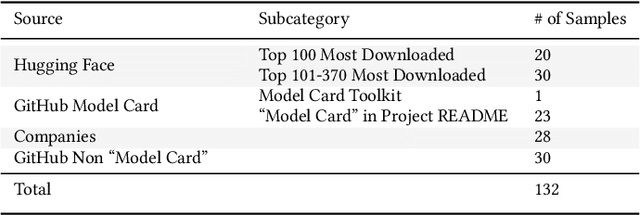
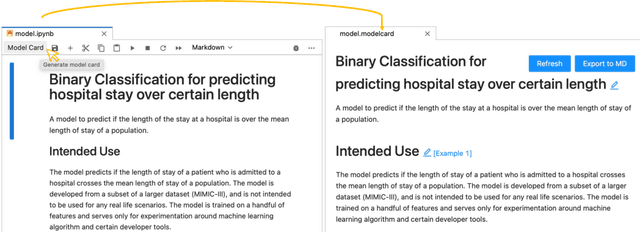
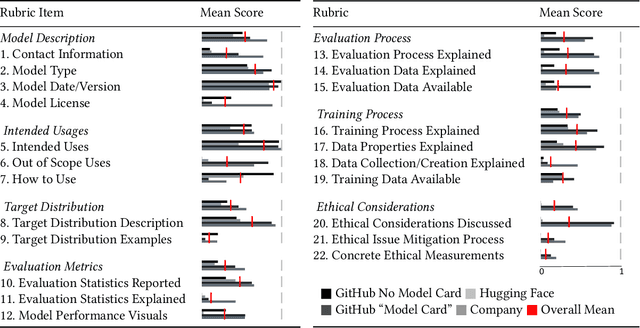

Abstract:Machine learning models have been widely developed, released, and adopted in numerous applications. Meanwhile, the documentation practice for machine learning models often falls short of established practices for traditional software components, which impedes model accountability, inadvertently abets inappropriate or misuse of models, and may trigger negative social impact. Recently, model cards, a template for documenting machine learning models, have attracted notable attention, but their impact on the practice of model documentation is unclear. In this work, we examine publicly available model cards and other similar documentation. Our analysis reveals a substantial gap between the suggestions made in the original model card work and the content in actual documentation. Motivated by this observation and literature on fields such as software documentation, interaction design, and traceability, we further propose a set of design guidelines that aim to support the documentation practice for machine learning models including (1) the collocation of documentation environment with the coding environment, (2) nudging the consideration of model card sections during model development, and (3) documentation derived from and traced to the source. We designed a prototype tool named DocML following those guidelines to support model development in computational notebooks. A lab study reveals the benefit of our tool to shift the behavior of data scientists towards documentation quality and accountability.
Semi-supervised Nonnegative Matrix Factorization for Document Classification
Feb 28, 2022
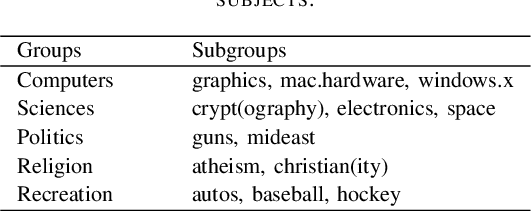
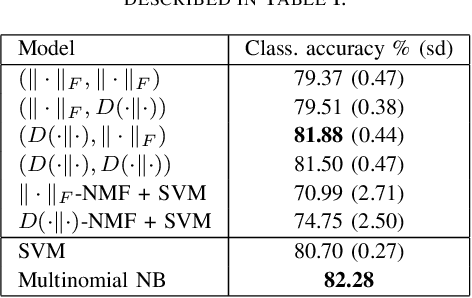

Abstract:We propose new semi-supervised nonnegative matrix factorization (SSNMF) models for document classification and provide motivation for these models as maximum likelihood estimators. The proposed SSNMF models simultaneously provide both a topic model and a model for classification, thereby offering highly interpretable classification results. We derive training methods using multiplicative updates for each new model, and demonstrate the application of these models to single-label and multi-label document classification, although the models are flexible to other supervised learning tasks such as regression. We illustrate the promise of these models and training methods on document classification datasets (e.g., 20 Newsgroups, Reuters).
Semi-supervised NMF Models for Topic Modeling in Learning Tasks
Oct 15, 2020



Abstract:We propose several new models for semi-supervised nonnegative matrix factorization (SSNMF) and provide motivation for SSNMF models as maximum likelihood estimators given specific distributions of uncertainty. We present multiplicative updates training methods for each new model, and demonstrate the application of these models to classification, although they are flexible to other supervised learning tasks. We illustrate the promise of these models and training methods on both synthetic and real data, and achieve high classification accuracy on the 20 Newsgroups dataset.
 Add to Chrome
Add to Chrome Add to Firefox
Add to Firefox Add to Edge
Add to Edge